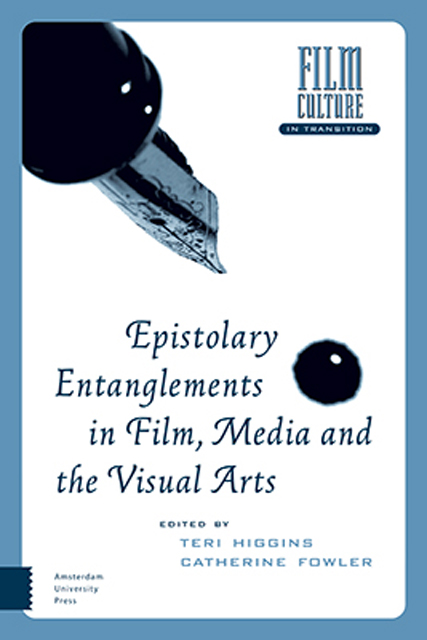Book contents
- Frontmatter
- Table of Contents
- Acknowledgements
- Doing (Audio-Visual) Things with Words – From Epistolary Intent to Epistolary Entanglements: An Introduction
- 1 Performance and Power : The Letter as an Expression of Masculinity in Game of Thrones
- 2 ‘My dearest little girl, I just got your letter and I hope that you will continue to write to me often’: Epistolary Listening in News from Home (Chantal Akerman, 1976)
- 3 Dead Letters: Epistolary Hauntology and the Speed of Light in Personal Shopper (Olivier Assayas, 2016)
- 4 Attention to Detail: Epistolary Forms in New Melodrama
- 5 The Spiritual Intimacies of The Red Hand Files: How Long Will I Be Alone?
- 6 Video Authenticity and Epistolary Self-Expression in Letter to America (Kira Muratova, 1999)
- 7 Epistolary Affect and Romance Scams: Letter from an Unknown Woman
- 8 Delivering Posthumous Messages : Katherine Mansfield and Letters in the Literary Biopic Leave All Fair (John Reid, 1985)
- 9 The Interactive Letter : Co-Authorship and Interactive Media in Emily Short’s First Draft of the Revolution
- 10 Epistolary Distance and Reciprocity in José Luis Guerín and Jonas Mekas’s Filmed Correspondences
- 11 Instagram and the Diary : The Case of Amalia Ulman’s Excellences & Perfections (2014)
- 12 Civil War Epistolary and the Hollywood War Film
- 13 Epistolarity and Decolonial Aesthetics in Carola Grahn’s Look Who’s Talking (2016)
- 14 Epistolary Relays in Fatih Akin’s Auf der anderen Seite (On the Other Side/On the Edge of Heaven) (2007)
- Index
13 - Epistolarity and Decolonial Aesthetics in Carola Grahn’s Look Who’s Talking (2016)
Published online by Cambridge University Press: 20 June 2023
- Frontmatter
- Table of Contents
- Acknowledgements
- Doing (Audio-Visual) Things with Words – From Epistolary Intent to Epistolary Entanglements: An Introduction
- 1 Performance and Power : The Letter as an Expression of Masculinity in Game of Thrones
- 2 ‘My dearest little girl, I just got your letter and I hope that you will continue to write to me often’: Epistolary Listening in News from Home (Chantal Akerman, 1976)
- 3 Dead Letters: Epistolary Hauntology and the Speed of Light in Personal Shopper (Olivier Assayas, 2016)
- 4 Attention to Detail: Epistolary Forms in New Melodrama
- 5 The Spiritual Intimacies of The Red Hand Files: How Long Will I Be Alone?
- 6 Video Authenticity and Epistolary Self-Expression in Letter to America (Kira Muratova, 1999)
- 7 Epistolary Affect and Romance Scams: Letter from an Unknown Woman
- 8 Delivering Posthumous Messages : Katherine Mansfield and Letters in the Literary Biopic Leave All Fair (John Reid, 1985)
- 9 The Interactive Letter : Co-Authorship and Interactive Media in Emily Short’s First Draft of the Revolution
- 10 Epistolary Distance and Reciprocity in José Luis Guerín and Jonas Mekas’s Filmed Correspondences
- 11 Instagram and the Diary : The Case of Amalia Ulman’s Excellences & Perfections (2014)
- 12 Civil War Epistolary and the Hollywood War Film
- 13 Epistolarity and Decolonial Aesthetics in Carola Grahn’s Look Who’s Talking (2016)
- 14 Epistolary Relays in Fatih Akin’s Auf der anderen Seite (On the Other Side/On the Edge of Heaven) (2007)
- Index
Summary
Abstract
This chapter explores how Sámi artist Carola Grahn's silent video, Look Who's Talking (2016), creatively intervenes in newer digital epistolary formats to recalibrate them for a decolonizing project. Specifically, I attend to how Grahn mobilizes ‘epistolarity’, to borrow Hamid Naficy's term, in ways that subvert colonial image histories, practices, and gazes. I also analyse the implications of how this epistolarity is, as Naficy argues, ‘produced under erasure’, in this case, the systemic erasure of Indigenous languages across the globe as mandated by state-sanctioned ‘educational’ institutions. To conclude, I consider the significance of Look Who's Talking's exhibitionary context (Among All These Tundras, 2018–2019) and, in particular, its dialogic relation to works by other Indigenous artists of the circumpolar north.
Keywords: decolonial aesthetics; electronic epistolarity; video installation; Sámi culture; Hamid Naficy
Métis artist David Garneau's painting, Aboriginal Curatorial Collective Meeting (2011), is composed of nine frames, each containing a series of speech bubbles resembling the kind one might encounter in a comic book or graphic novel. However, the words – and those presumably speaking them – are missing. For Garneau, this image ‘tries to picture irreconcilable spaces of Indigeneity without giving away any content’ and, in the process, attempts to ‘signal that something interesting is going on beyond the colonial gaze’. In other words, for Garneau, his painting is a resistance to the scopophilia that underpins a colonial drive, one also motivated by ‘an urge to penetrate, to traverse, to know, to translate, to own and exploit’. It is an act of ‘refusing translation and full explanation’, of preserving sites and spaces in which Indigenous peoples speak ‘with one's own and in one's own way’ beyond the scopic and representational regimes of white settler-colonizers.
In Sámi artist Carola Grahn's silent video Look Who's Talking (2016, 3min 40sec, looped), the scopic and epistephilic regimes of white settler-colonizers are also thwarted. Apart from a few emojis, simple line drawings, black and white portraits of Game of Thrones (2011–2019) characters, and an animated celestial map, the work does not contain any images. Neither Indigenous bodies – including Grahn's – nor Sámi cultural practices or spiritual sites are subject to representation. There are no picturesque sites of Sápmi to aestheticize Grahn's words about her travels or give visual form to the reductive tropes historically associated with Sámi life.
- Type
- Chapter
- Information
- Epistolary Entanglements in Film, Media and the Visual Arts , pp. 241 - 258Publisher: Amsterdam University PressPrint publication year: 2023



